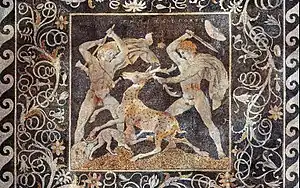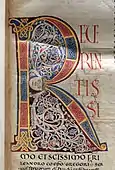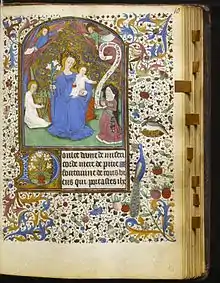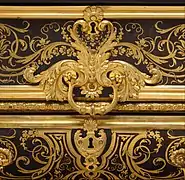Rinceau
In architecture and the decorative arts, a rinceau (plural rinceaux; from the French, derived from old French rain 'branch with foliage') is a decorative form consisting of a continuous wavy stemlike motif from which smaller leafy stems or groups of leaves branch out at more or less regular intervals. The English term scroll is more often used in English, especially when the pattern is regular, repeating along a narrow zone. In English "rinceau" tends to be used where the design spreads across a wider zone, in a similar style to an Islamic arabesque pattern.
The use of rinceaux is frequent in the friezes of Roman buildings, where it is generally found in a frieze, the middle element of an entablature, just below the cornice. It is also decorated in the jamb ornaments and capitals of Romanesque structures and in friezes and panels of buildings in the various Renaissance styles, where tiny animals or human heads also appear.[1]
The rinceau experienced a return to the simpler Classic style in the 17th century, and in the subsequent century it was applied more freely, without a strict repetition of identical forms.[2]
Gallery
 The Hellenistic mosaic of Pella's Deer Hunt, surrounded by floral rinceaux, 4th century BC
The Hellenistic mosaic of Pella's Deer Hunt, surrounded by floral rinceaux, 4th century BC
.jpg.webp) Roman mosaic with a peacock lost in a forest of rinceaux, in the Bardo National Museum from Tunis (Tunisia)
Roman mosaic with a peacock lost in a forest of rinceaux, in the Bardo National Museum from Tunis (Tunisia).jpg.webp) Golden Paleochristian rinceaux on a midnight blue mosaic background decorating the Baptistery of Neon from Ravenna (Italy), 5th century
Golden Paleochristian rinceaux on a midnight blue mosaic background decorating the Baptistery of Neon from Ravenna (Italy), 5th century 12th century mosaic on the apse of the San Clemente al Laterano of the Lateran, illustrating the continuity of Ancient and early Christian models in Rome throughout the Middle Ages
12th century mosaic on the apse of the San Clemente al Laterano of the Lateran, illustrating the continuity of Ancient and early Christian models in Rome throughout the Middle Ages Illuminatied R in a Medieval Italian manuscript, circa 1150
Illuminatied R in a Medieval Italian manuscript, circa 1150.jpg.webp)
.jpg.webp) Page of a Gothic illuminated manuscript with rinceaux and foliage ornaments
Page of a Gothic illuminated manuscript with rinceaux and foliage ornaments Gothic page from a Book of Hours, circa 1460
Gothic page from a Book of Hours, circa 1460 Renaissance rinceaux, as here in the Albi Cathedral, are inspired by medieval illuminations but also Roman grotesques
Renaissance rinceaux, as here in the Albi Cathedral, are inspired by medieval illuminations but also Roman grotesques Marquetry and gilded bronzes with delicate Louis XIV style rinceaux, typical of André-Charles Boulle's works
Marquetry and gilded bronzes with delicate Louis XIV style rinceaux, typical of André-Charles Boulle's works%252C_rinceaux%252C_No%C3%A9mie_Constant_01.jpg.webp) Renaissance Revival relief with putti, detail of the Fontaine Saint-Michel from Paris, from 1858-1860
Renaissance Revival relief with putti, detail of the Fontaine Saint-Michel from Paris, from 1858-1860
Notes
- Cf. J. Ward, Historic Ornament: Treatise on Decorative Art and Architectural Ornament, BiblioBazaar (2009), s.v. Rinceau.
- Cf. A. Speltz, The History of Ornament: Design in the Decorative Arts, Portland (1989), s.v.
See also
External links
- Decorating with Art, Antiques and Collectibles
- Home Economics Archive: Tradition, Research, History (HEARTH)
An e-book collection of over 1,000 books on home economics spanning 1850 to 1950, created by Cornell University's Mann Library. Includes several hundred e-books on decorative art and design, particularly that created within the home. - Victoria and Albert Museum
- The Bard Graduate Center (BGC) for Studies in the Decorative Arts, Design and Culture
- Parsons/Cooper-Hewitt Program in the History of Decorative Arts & Design
- Digital Library for the Decorative Arts and Material Culture - electronic resources
- Metropolitan Museum of Art American decorative arts collection
- National Gallery of Art decorative arts collection
.jpg.webp)
